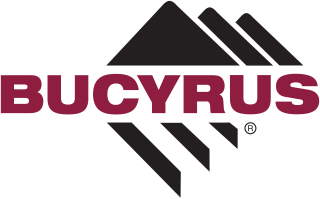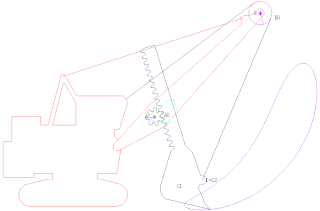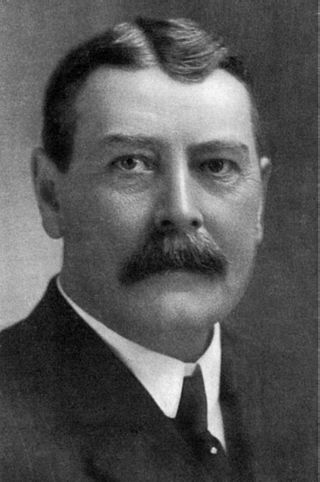
Excavators are heavy construction equipment primarily consisting of a boom, dipper, bucket and cab on a rotating platform known as the "house" - although the largest form ever, the dragline excavator, eliminated the dipper in favor of a line and winch.

A dragline excavator is a heavy-duty excavator used in civil engineering and surface mining. It was invented in 1904, and presented an immediate challenge to the steam shovel (and its diesel and electric powered descendant, the power shovel. Much more efficient than even the largest of the latter, it enjoyed a heyday in extreme size for most of the 20th century, first becoming challenged by more efficient rotary excavators in the 1950s, then superseded by them on the upper end from the 1970s on.

A steam shovel is a large steam-powered excavating machine designed for lifting and moving material such as rock and soil. It is the earliest type of power shovel or excavator. Steam shovels played a major role in public works in the 19th and early 20th century, being key to the construction of railroads and the Panama Canal. The development of simpler, cheaper diesel, gasoline and electric shovels caused steam shovels to fall out of favor in the 1930s.

Big Brutus is the nickname of the Bucyrus-Erie model 1850-B electric shovel, which was the second largest of its type in operation in the 1960s and 1970s. Big Brutus is the centerpiece of a mining museum in West Mineral, Kansas, United States, where it was used in coal strip mining operations. The shovel was designed to dig from 20 to 69 feet down to unearth relatively shallow coal seams, which would then be mined with smaller equipment.

The Culebra Cut, formerly called Gaillard Cut, is an artificial valley that cuts through the Continental Divide in Panama. The cut forms part of the Panama Canal, linking Gatun Lake, and thereby the Atlantic Ocean, to the Gulf of Panama and hence the Pacific Ocean. It is 7.8 miles (12.6 km) from the Pedro Miguel lock on the Pacific side to the Chagres River arm of Lake Gatun, with a water level 85 feet (26 m) above sea level.

Bagger 288, previously known as the MAN TAKRAF RB288 built by the German company Krupp for the energy and mining firm Rheinbraun, is a bucket-wheel excavator or mobile strip mining machine.

A bucket-wheel excavator (BWE) is a large heavy equipment machine used in surface mining.

Marion Power Shovel Company was an American firm that designed, manufactured and sold steam shovels, power shovels, blast hole drills, excavators, and dragline excavators for use in the construction and mining industries. The company was a major supplier of steam shovels for the construction of the Panama Canal. The company also built the two crawler-transporters used by NASA for transporting the Saturn V rocket and later the Space Shuttle to their launch pads. The company's shovels played a major role in excavation for Hoover Dam, the Holland Tunnel and the extension of the Number 7 subway line to Main Street in Flushing, Queens.

Big Muskie was a dragline excavator built by Bucyrus-Erie and owned by the Central Ohio Coal Company, weighing 13,500 short tons (12,200 t) and standing nearly 22 stories tall. It mined coal in the U.S. state of Ohio from 1969 to 1991. It was dismantled and sold for scrap in 1999.

Bucyrus-Erie was an American surface and underground mining equipment company. It was founded as Bucyrus Foundry and Manufacturing Company in Bucyrus, Ohio, in 1880. Bucyrus moved its headquarters to South Milwaukee, Wisconsin, in 1893. In 1927, Bucyrus merged with the Erie Steam Shovel Company to form Bucyrus-Erie. In 1997, it was renamed Bucyrus International, Inc. In 2010 the enterprise was purchased by Caterpillar in a US$7.6 billion transaction that closed on July 8, 2011. At the time of its acquisition, the Bucyrus product line included a range of material removal and material handling products used in both surface and underground mining.

A power shovel, also known as a motor shovel, stripping shovel, front shovel, mining shovel or rope shovel, is a bucket-equipped machine usually powered by steam, diesel fuel, gasoline or electricity and used for digging and loading earth or fragmented rock and for mineral extraction. Power shovels are a type of rope/cable excavator, where the digging arm is controlled and powered by winches and steel ropes, rather than hydraulics like in the modern hydraulic excavators. Basic parts of a power shovel include the track system, cabin, cables, rack, stick, boom foot-pin, saddle block, boom, boom point sheaves and bucket. The size of bucket varies from 0.73 to 53 cubic meters.

F60 is the series designation of five overburden conveyor bridges used in brown coal (lignite) opencast mining in the Lusatian coalfields in Germany. They were built by the former Volkseigener Betrieb TAKRAF in Lauchhammer and are the largest movable technical industrial machines in the world. As overburden conveyor bridges, they transport the overburden which lies over the coal seam. The cutting height is 60 m (200 ft), hence the name F60. In total, the F60 is up to 80 m (260 ft) high and 240 m (790 ft) wide; with a length of 502 m (1,647 ft), it is described as the lying Eiffel Tower, making these behemoths not only the longest vehicle ever made—beating Prelude FLNG, the longest ship—but the largest vehicle by physical dimensions ever made by humankind. In operating condition, it weighs 13,600 metric tons making the F60 also one of the heaviest land vehicles ever made, beaten only by Bagger 293, which is a giant bucket-wheel excavator. Nevertheless, despite its immense size, it is operated by only a crew of 14.
Marion 6360, also known as The Captain, was a giant power shovel built by the Marion Power Shovel company. Completed and commissioned on October 15 1965, it was one of the largest land vehicles ever built, exceeded only by some dragline and bucket-wheel excavators. The shovel originally started work with Southwestern Illinois Coal Corporation, but the owners were soon bought out by Arch Coal. Everything remained the same at the mine except for the colors which were changed to red, white, and blue. Like most mining vehicles of extreme size, Marion 6360 only required a surprisingly small amount of men to operate, a total of four consisting of a operator, oiler, welder, and a ground man who looked after the trailing cable.
The Harrison County History of Coal Museum, also known as the Puskarich Coal Museum, is a non-profit educational museum featuring information about coal mining. It opened in May 1994 in Cadiz, Ohio in the lower level of the Puskarich Public Library. The museum is open during the libraries' normal business hours from Monday - Thursday 9:00-8:00, Friday 9:00-6:00, and Saturday 9:00-5:00. Tours can be arranged by appointment. Admission is free of charge.

The Ursa Major at Black Thunder Coal Mine, Wyoming, is the largest dragline excavator currently in use in North America and the third largest ever built. It is a Bucyrus-Erie 2570WS model and cost US$50 million. The Ursa Major was one of five large walking draglines operated at Black Thunder, with the next two largest in the dragline fleet being Thor, a B-E 1570W - which has a 97.5-metre (320 ft) boom and a 69-cubic-metre (2,400 cu ft) bucket - and Walking Stick, a B-E 1300W with a 92-metre (302 ft) boom and a 34-cubic-metre (1,200 cu ft) bucket.

P&H Mining Equipment sells drilling and material handling machinery under the "P&H" trademark. The firm is an operating subsidiary of Joy Global Inc. In 2017 Joy Global Inc. was acquired by Komatsu Limited of Tokyo, Japan, and is now known as Komatsu Mining Corporation and operates as a subsidiary of Komatsu.

The Marion Steam Shovel, also known as the Le Roy Steam Shovel, is a historic Model 91 steam shovel manufactured by the Marion Steam Shovel and Dredge Company of Marion, Ohio. It is located on Gulf Road in the Town of Le Roy, New York, United States.

Joy Global Inc. was a company that manufactured and serviced heavy equipment used in the extraction and haulage of coal and minerals in both underground and surface mining. The company had manufacturing facilities in Alabama, Pennsylvania, Texas, Wisconsin, Australia, Canada, China, France, South Africa, Poland and the United Kingdom. In 2017, Joy Global was acquired by Komatsu Limited and was renamed Komatsu Mining Corp.

The GEM of Egypt was a power shovel used for strip mining built by Bucyrus-Erie in 1966 for working the Egypt Valley coalfield near Barnesville, Ohio. GEM is an acronym for “Giant Earth Mover” or “Giant Excavating Machine”. It was one of only two Bucyrus-Erie 1950-B shovels built and one of two to use the knee action crowd licensed from Marion Power Shovel in exchange to Marion's use of BE's cable crowd patent.

Dredge No. 4 is a wooden-hulled bucketline sluice dredge that mined placer gold on the Yukon River from 1913 until 1959. It is now located along Bonanza Creek Road 13 kilometres (8.1 mi) south of the Klondike Highway near Dawson City, Yukon, where it is preserved as one of the National Historic Sites of Canada. It is the largest wooden-hulled dredge in North America.


















